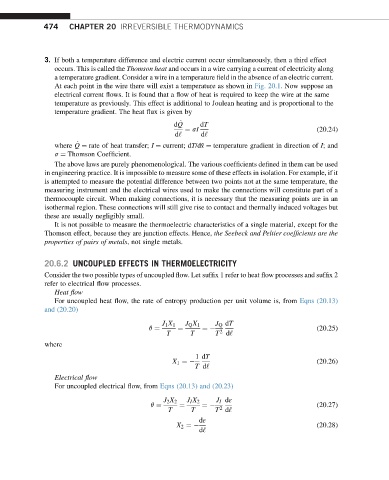Page 482 - Advanced thermodynamics for engineers
P. 482
474 CHAPTER 20 IRREVERSIBLE THERMODYNAMICS
3. If both a temperature difference and electric current occur simultaneously, then a third effect
occurs. This is called the Thomson heat and occurs in a wire carrying a current of electricity along
a temperature gradient. Consider a wire in a temperature field in the absence of an electric current.
At each point in the wire there will exist a temperature as shown in Fig. 20.1. Now suppose an
electrical current flows. It is found that a flow of heat is required to keep the wire at the same
temperature as previously. This effect is additional to Joulean heating and is proportional to the
temperature gradient. The heat flux is given by
dQ _ dT
¼ sI (20.24)
d‘ d‘
_
where Q ¼ rate of heat transfer; I ¼ current; dT/d[ ¼ temperature gradient in direction of I; and
s ¼ Thomson Coefficient.
The above laws are purely phenomenological. The various coefficients defined in them can be used
in engineering practice. It is impossible to measure some of these effects in isolation. For example, if it
is attempted to measure the potential difference between two points not at the same temperature, the
measuring instrument and the electrical wires used to make the connections will constitute part of a
thermocouple circuit. When making connections, it is necessary that the measuring points are in an
isothermal region. These connections will still give rise to contact and thermally induced voltages but
these are usually negligibly small.
It is not possible to measure the thermoelectric characteristics of a single material, except for the
Thomson effect, because they are junction effects. Hence, the Seebeck and Peltier coefficients are the
properties of pairs of metals, not single metals.
20.6.2 UNCOUPLED EFFECTS IN THERMOELECTRICITY
Consider the two possible types of uncoupled flow. Let suffix 1 refer to heat flow processes and suffix 2
refer to electrical flow processes.
Heat flow
For uncoupled heat flow, the rate of entropy production per unit volume is, from Eqns (20.13)
and (20.20)
J 1 X 1 J Q X 1 J Q dT
q ¼ ¼ ¼ (20.25)
2
T T T d‘
where
1 dT
X 1 ¼ (20.26)
T d‘
Electrical flow
For uncoupled electrical flow, from Eqns (20.13) and (20.23)
J 2 X 2 J I X 2 J I dε
q ¼ ¼ ¼ (20.27)
2
T T T d‘
dε
X 2 ¼ (20.28)
d‘

